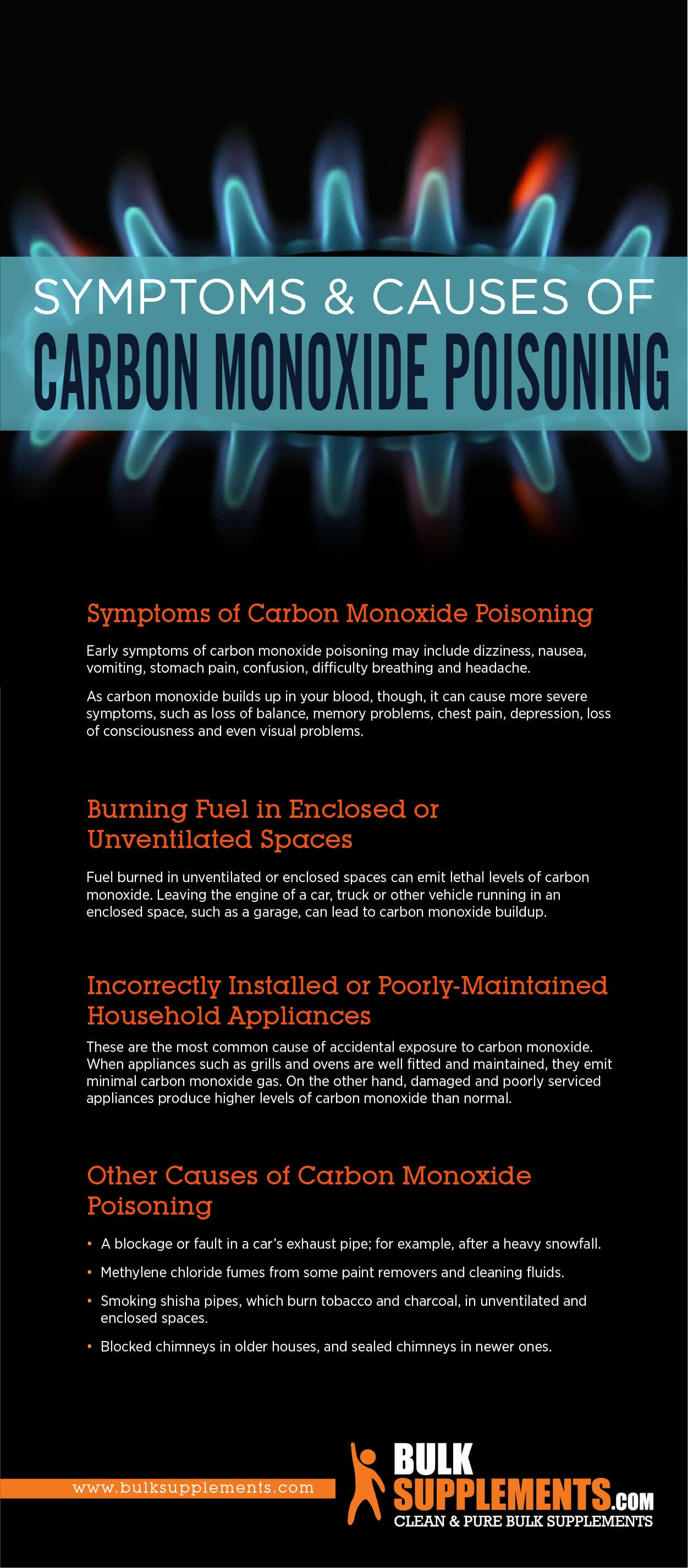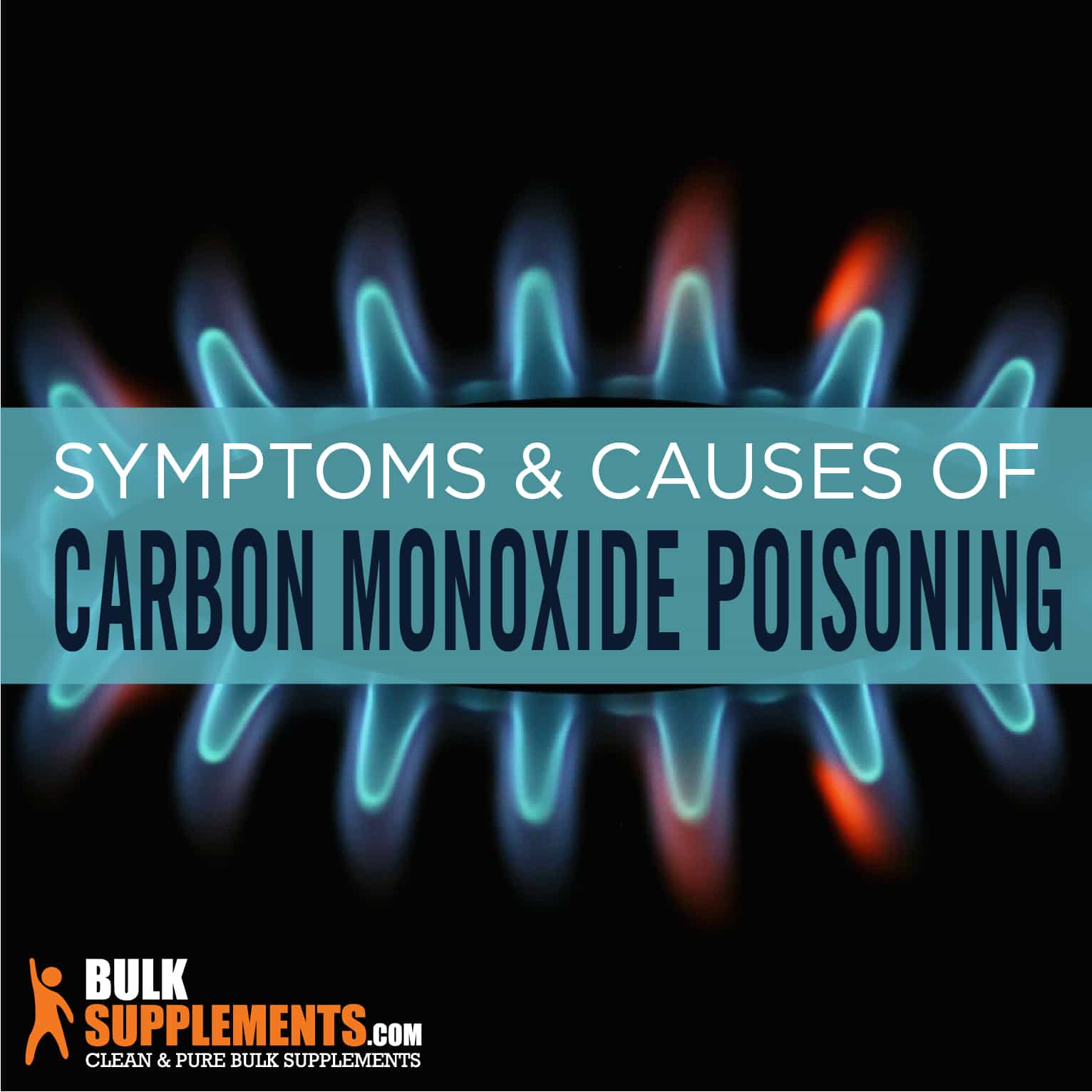Carbon monoxide poisoning occurs when you have too much carbon monoxide in your body. Carbon monoxide is a poisonous colorless, odorless and tasteless gas, and it’s a byproduct of burning materials that contain carbon, such as propane, charcoal, wood, gasoline and natural gas (x). Many know it as the “silent killer” because neither humans nor animals can detect it. It can be fatal.
Everyday household items that burn fuel put out a little carbon monoxide. Grills, ovens, portable generators and water heaters all do it. However, improper or nonfunctional ventilation can allow carbon monoxide to accumulate to dangerous levels. When there’s too much carbon monoxide in the air, it enters the bloodstream and mixes with hemoglobin to form carboxyhemoglobin (x). Once it displaces the oxygen in your blood, cells and tissues throughout your body fail and die. And major organs such as the heart and brain stop working.
Symptoms of Carbon Monoxide Poisoning
Early symptoms of carbon monoxide poisoning may include dizziness, nausea, vomiting, stomach pain, confusion, difficulty breathing and headache (x).
As carbon monoxide builds up in your blood, though, it can cause more severe symptoms, such as loss of balance, memory problems, chest pain, depression, loss of consciousness and even visual problems (x).
Causes of Carbon Monoxide Poisoning
Burning Fuel in Enclosed or Unventilated Spaces
Fuel burned in unventilated or enclosed spaces can emit lethal levels of carbon monoxide. Leaving the engine of a car, truck or other vehicle running in an enclosed space, such as a garage, can lead to carbon monoxide buildup.
Incorrectly Installed or Poorly-Maintained Household Appliances
These are the most common cause of accidental exposure to carbon monoxide. When appliances such as grills and ovens are well fitted and maintained, they emit minimal carbon monoxide gas. On the other hand, damaged and poorly serviced appliances produce higher levels of carbon monoxide than normal.
Other Causes of Carbon Monoxide Poisoning
- A blockage or fault in a car’s exhaust pipe; for example, after a heavy snowfall.
- Methylene chloride fumes from some paint removers and cleaning fluids.
- Smoking shisha pipes, which burn tobacco and charcoal, in unventilated and enclosed spaces.
- Blocked chimneys in older houses, and sealed chimneys in newer ones (x).

Risk Factors of Carbon Monoxide Poisoning
Certain people are more susceptible to carbon monoxide poisoning than others (x). Exposure to carbon monoxide may be particularly dangerous for the following people:
Unborn Babies and Young Children
Unborn babies are more susceptible to carbon monoxide poisoning because their blood cells can take up carbon monoxide gas more readily than those of adults. Young children may also be more susceptible to carbon monoxide gas emissions because they take breaths more frequently than adults do.
Older Adults and People with Heart Problems
Older adults are highly at risk and are more likely to develop brain damage from carbon monoxide poisoning. People with chronic heart diseases, anemia or breathing problems are also more likely to get sick from less exposure to carbon monoxide than others are.
Complications of Carbon Monoxide Poisoning
Carbon monoxide poisoning can cause severe, long-lasting complications. Here are some of them:
Permanent Brain Damage
Carbon monoxide poisoning may cause progressive memory loss and concentration difficulty. It could also lead to hearing and vision loss. Prolonged exposure to carbon monoxide has even shown to cause parkinsonism, a neurological disorder resembling Parkinson’s disease. Parkinson’s disease is a chronic neurological (brain) condition characterized by stiffness, shaking and slow movement (x).
Heart Damage and Urinary Incontinence
Prolonged exposure to carbon monoxide gas emissions may cause heart damage and coronary heart disease (x). Moreover, this condition is characterized by involuntary urination. Some with severe carbon monoxide poisoning have shown this symptom (x).
Fetal Death or Miscarriage
Pregnant women exposed to carbon monoxide may cause harm to their unborn babies. If a fetus has been exposed to carbon monoxide during pregnancy, perinatal death can occur. Low birth weight and behavioral problems are also possible in newborns exposed to carbon monoxide during pregnancy (x).
Carbon Monoxide Poisoning Diagnosis
The signs and symptoms of carbon monoxide poisoning are unspecific and can be hard to attribute at first. The flu and similar health problems show matching symptoms to early-stage carbon monoxide poisoning. Your doctor may suspect complaints of nausea and severe headaches during winter months to be early symptoms of the flu, especially if other household members, co-workers or even pets have similar symptoms.
If your doctor suspects carbon monoxide poisoning, they may order a blood test to check for carboxyhemoglobin in your blood. This is the most effective way for your doctor to make a diagnosis. A carboxyhemoglobin blood level of 30 percent or higher indicates severe exposure (x).
The blood test can also help your doctor look for other health problems exposure has caused. Blood test results for smokers can be difficult to interpret as smokers already have higher than normal levels of carboxyhemoglobin in their blood.
Treatments and Remedies for Carbon Monoxide Poisoning
Peppermint
Native to the United States, peppermint can help ease the mild symptoms of carbon monoxide poisoning — nausea, stomach pains, dizziness and vomiting. Peppermint has a long, global history of use in folklore, and scientific evidence supports its ability to relieve stomach disorders and nausea (x). Seven hundred milligrams (about 1/3 tablespoon) of peppermint extract can be taken once or twice a day to help ease some of these symptoms.
Oxygen Therapy
In the hospital, if you have symptoms consistent with carbon monoxide exposure, doctors will administer standard oxygen therapy. It involves administering high-flow 100 percent oxygen through an oxygen mask to displace carbon monoxide in the blood and speed up the production of oxyhemoglobin. The therapy will continue until your carboxyhemoglobin blood levels fall below 10 percent.
It takes about 320 minutes — more than five hours — to eliminate half of the body’s carbon monoxide without using oxygen. Oxygen therapy lowers that time to about 74 minutes. And it takes about five hours of therapy to reach acceptable levels of carbon monoxide in the blood (x).
Hyperbaric Oxygen Therapy
If you have extensive exposure to carbon monoxide, and your doctor suspects nerve damage, they may administer hyperbaric oxygen therapy (HBOT) instead. You would breathe in 100 percent oxygen in a hyperbaric chamber, in which air pressure is about two to three times higher than normal (x). This treatment floods the blood with pure oxygen, which accelerates the displacement of carbon monoxide. With hyperbaric oxygen therapy, doctors can eliminate half of the blood’s carbon monoxide in about 20 minutes (x).
Unfortunately, hyperbaric oxygen therapy is a specialized technique not readily available; it may take hours to arrange treatment. Although there’s evidence that hyperbaric oxygen therapy helps eliminate carbon monoxide in the blood faster, there’s insufficient evidence regarding its long-term effectiveness for treating it (x).
Doctors may recommend HBOT in certain situations. They may, for example, reserve the treatment for patients with reduced brain activity or natural oxygen supply. Or they may reserve the treatment for pregnant women, since fetuses are highly susceptible to damage from carbon monoxide poisoning.
How to Prevent Carbon Monoxide Poisoning
Safe Use of Vehicles
- Check your vehicle’s exhaust system each year for leaks.
- Don’t leave gasoline-fueled engines — for example, lawn mowers or motorbikes — running in a garage.
- To prevent carbon monoxide from being sucked into a tailgate, open the doors and windows when the tailgate is open.
- Do not swim near idling Jet Skis or boats, or those operating at low speeds.
- Do not sit in running vehicles with blocked exhausts or tailpipes.
Safe Use of Fuel-Burning Appliances
- Ensure your appliances, such as cooktops, gas ovens and furnaces are inspected for adequate ventilation.
- Only use gas-powered generators and engines outdoors or in well-ventilated spaces.
- Do not use a gas heater or oven to heat your home.
- Save charcoal/gas grills or portable camp stoves for outdoor use only.
- Ensure you use a space heater only when someone is available to keep an eye on it, and make sure doors and windows are open.
- Have a reputable and qualified technician install and regularly service heating systems, cooker boilers or any other fuel-burning appliances.
- Do not use a generator within 20 feet of a door, window or vent.
Other Safety Tips
To minimize your chances of getting carbon monoxide poisoning, ensure you wear a mask when using products that contain methylene chloride, and use them outside and in well-ventilated spaces. Also make sure rooms are well ventilated and air vents are opened. Do not sleep in rooms that have paraffin heaters.
Be sure a qualified sweeper regularly checks and sweeps all chimneys, flues and vents. Finally, install a carbon monoxide alarm to detect high levels of carbon monoxide. Remember that these alarms only serve as backup safety measures and can’t replace the need for regular appliance checks and servicing.
The Bottom Line
Carbon monoxide is a silent killer that can be deadly within minutes if you breathe too much in. Sources that burn fuel emit it, and common household items such as generators, charcoal grills and cookers put people at risk of exposure to this poisonous gas.
Symptoms of carbon monoxide poisoning can be mild — nausea and stomach pain — to severe and can cause long-term issues, such as heart damage. Mild symptoms can be relieved with supplements such as peppermint extract, but severe ones will require high doses of oxygen to alleviate.


